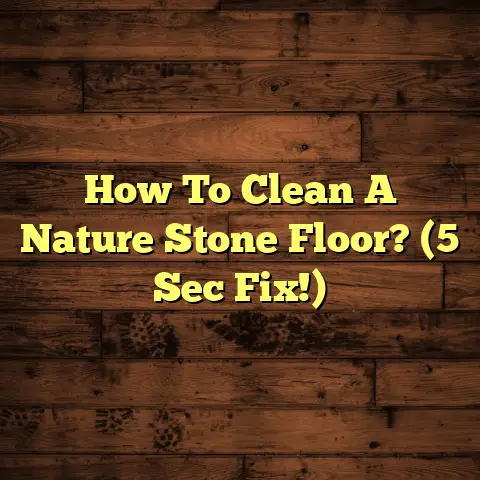Hardwood Floor Colors 2025 (1 Style Outdated!)
From the shag carpet era (shudder!) to the sleek, modern styles we’re seeing now, flooring trends are constantly evolving.
And let me tell you, 2025 is shaping up to be a game-changer!
But before we dive into the hottest colors, let’s talk about something close to my heart: sustainability.
We’re seeing a massive shift towards eco-conscious choices, and that includes what we put under our feet.
People are realizing that beautiful floors don’t have to come at the expense of the planet.
Hardwood, when sourced responsibly, is a fantastic option.
It’s durable, adds value to your home, and can be a sustainable choice.
So, let’s get into the exciting stuff!
Section 1: The Evolution of Hardwood Floor Colors
Think back to your grandma’s house. Remember those orange-toned oak floors?
That was the “it” thing for a while!
Over the decades, we’ve seen a rollercoaster of trends.
In the 80s and 90s, dark, glossy finishes were all the rage.
Then came the early 2000s with their honey-colored hues.
These trends weren’t just random; they reflected broader design movements.
- The minimalist movement of the 90s pushed for cleaner, simpler designs.
- The rise of “HGTV culture” influenced consumer preferences, making people more aware of design possibilities.
Cultural shifts also play a huge role.
For example, the Scandinavian design aesthetic, with its emphasis on light and natural elements, has significantly influenced the popularity of light wood floors.
Section 2: Current Trends in Hardwood Floor Colors for 2025
Alright, let’s get to the good stuff!
What colors are going to be hot in 2025?
Here’s a sneak peek:
Light Woods (Natural Oak, Birch)
Light woods are HUGE right now, and they’re only going to get bigger.
Think natural oak, birch, and even lighter-toned maples.
These colors create a bright, airy feel, making rooms feel larger and more inviting.
They’re perfect for modern, minimalist, and Scandinavian-inspired spaces.
Why they’re trending:
- They reflect light, making rooms feel brighter.
- They’re versatile and can be paired with a variety of design styles.
- They create a clean, modern aesthetic.
Dark Woods (Walnut, Ebony)
On the opposite end of the spectrum, dark woods like walnut and ebony are making a strong comeback.
These colors add drama and sophistication to any space.
They work particularly well in larger rooms with plenty of natural light.
Why they’re trending:
- They add a touch of luxury and elegance.
- They create a strong contrast with lighter-colored walls and furniture.
- They’re perfect for creating a cozy, intimate atmosphere.
Gray and Greige Tones
Gray has been a popular color for years, and it’s not going anywhere.
But in 2025, we’re seeing a shift towards “greige” – a blend of gray and beige.
These tones are incredibly versatile and work well with a variety of design styles.
Why they’re trending:
- They’re neutral and easy to coordinate with other colors.
- They add a touch of sophistication without being too stark.
- They’re perfect for creating a calm, relaxing atmosphere.
Rich, Warm Tones (Chestnut, Mahogany)
Remember those orange-toned floors I mentioned earlier?
Well, warm tones are making a comeback, but with a modern twist.
Think rich chestnuts, warm mahoganies, and deep cherry hues.
These colors add warmth and character to any space.
Why they’re trending:
- They create a cozy, inviting atmosphere.
- They add a touch of vintage charm.
- They’re perfect for creating a sense of history and tradition.
Whites and Off-Whites
White floors?
Yes, you heard that right!
White and off-white floors are becoming increasingly popular, especially in modern and minimalist homes.
They create a clean, bright, and airy feel.
Why they’re trending:
- They maximize light and make rooms feel larger.
- They create a clean, minimalist aesthetic.
- They provide a blank canvas for other design elements.
How these colors complement modern interior design styles:
- Minimalism: Light woods, whites, and grays create a clean, uncluttered look.
- Industrial: Gray and greige tones complement the raw, edgy feel of industrial design.
- Scandinavian: Light woods and whites create a bright, airy, and natural atmosphere.
Section 3: The Outdated Style
Okay, time for the truth bomb.
There’s one hardwood floor color style that’s definitely on its way out:
Honey Oak with a Glossy Finish.
I know, I know, it was popular for a long time.
But trust me, it’s time to move on.
Why it’s falling out of favor:
- It looks dated: Let’s face it, it screams “1990s.”
- It clashes with modern design styles: It doesn’t work well with minimalist, industrial, or Scandinavian aesthetics.
- It shows dirt easily: That glossy finish highlights every speck of dust and grime.
Examples of its previous popularity:
- Think of every suburban home built in the 90s.
- It was the go-to choice for builders looking for an affordable and durable option.
Contrasting it with current trends:
- While honey oak is warm-toned, it lacks the sophistication and depth of the rich, warm tones that are currently trending.
- It’s also much more yellow than the natural, light woods that are so popular right now.
Section 4: Factors Influencing Color Choices
Choosing the right hardwood floor color is a big decision.
Here are some factors that homeowners should consider:
- Interior design trends: Obviously, you want your floors to complement your overall design style.
- Regional preferences: Coastal areas tend to favor lighter colors, while more traditional areas may prefer darker tones.
- Lighting and space considerations: Darker floors can make a small room feel even smaller, while lighter floors can brighten up a dark space.
- Lifestyle and functionality (pets, children, etc.): Lighter floors tend to hide scratches and dirt better than darker floors.
How climate and geographical location can affect color preferences:
- In sunny climates, lighter floors can help to keep rooms cool.
- In colder climates, darker floors can add warmth and coziness.
Section 5: The Impact of Technology on Hardwood Flooring
Technology has revolutionized the hardwood flooring industry.
We’re seeing innovations in:
- Finishes: New finishes are more durable, scratch-resistant, and water-resistant than ever before.
- Stains: Technology has allowed to create a wider range of colors and tones.
- Sustainable practices: Improved milling techniques reduce waste and maximize the use of resources.
Eco-friendly technologies:
- Water-based finishes: These finishes are low in VOCs (volatile organic compounds), making them safer for the environment and your health.
- Reclaimed wood: Reclaimed wood is salvaged from old buildings and structures, giving it a new life and reducing the demand for new lumber.
Section 6: Sustainable Choices in Hardwood Flooring
As I mentioned earlier, sustainability is a huge trend in the flooring industry.
Here’s what you need to know about making eco-conscious choices:
- Certifications: Look for certifications like FSC (Forest Stewardship Council) and PEFC (Programme for the Endorsement of Forest Certification). These certifications ensure that the wood is harvested from responsibly managed forests.
- Recycled and reclaimed wood: Consider using recycled or reclaimed wood. This is a great way to reduce waste and add character to your home.
Brands and manufacturers leading the way in sustainable hardwood flooring:
- [Insert brand name 1]: This company is committed to using sustainably harvested wood and eco-friendly finishes.
- [Insert brand name 2]: This manufacturer specializes in reclaimed wood flooring.
Section 7: Real-Life Applications and Case Studies
Let’s take a look at some real-life examples of homes featuring trending hardwood floor colors:
- Case Study 1: A modern minimalist apartment in New York City features light oak floors, creating a bright and airy feel.
- Case Study 2: A cozy farmhouse in the Midwest features rich chestnut floors, adding warmth and character to the space.
Interviews or quotes from interior designers or homeowners:
- “[Quote from designer about why they chose light wood floors for a client’s home]”
- “[Quote from homeowner about how their new gray floors transformed their living room]”
How these choices enhance the overall aesthetic and function of the space:
- Light floors make small spaces feel larger and brighter.
- Dark floors add drama and sophistication to larger rooms.
- Gray floors create a calm and relaxing atmosphere.
Conclusion
Choosing the right hardwood floor color can make a huge difference in the look and feel of your home.
By staying informed about current trends and making eco-conscious choices, you can create a beautiful and sustainable space that you’ll love for years to come.
So, ditch that honey oak, embrace the new trends, and let’s create some stunning floors together!





